I grew up with this Penstemon in my mothers gardens. Pollinated by bumble bees it has one of the largest flowers of the Penstemons. A gem from the Great Plains.
Here are shots of two color forms The pink being the more common. The white is a variant I ran across in a patch of pink ones about forty years ago. The seed from it will produce about 25% white offspring.
Comments
Re: Penstemon grandiflorus
Your "pink" shows very lavender on my screen, John. Our native strain is lavender-pink (too?). This one is grown from wild seed I collected in Isanti County, Minnesota, just north of St. Paul. It is remarkably durable through the season. The plant seems just as fresh in late August as it does in early June.
Re: Penstemon grandiflorus
Bob
In very dry sights they are monocarpic, as you point out, acting biannual in nature. There is little chance of losing them once established, since they produce copious amounts of seed.
Rick
Ya I have never been sure if I should call them pink or lavender.
I remember as a child waiting for a bumble bee to go into the flower. When it was all the way in, we would quick as a wink pinch the flower mouth shut. Then pluck it off the plant, the bee imprisoned in the blossom. It was thrilling to feel the bee buzzing at your finger tips. A quick toss of the blossom and run like hell, finished off these escapades.
Re: Penstemon grandiflorus
How high does this one grow please?
Re: Penstemon grandiflorus
It will grow from 12 - 24 inches (30-60cm) tall, the basal rosette will not get very large about 4-6 inches (10-15cm) across.
We have mentioned that in a dry environment it acts monocarpic, however if it receives even a little extra moisture during the growing season, It will hang around and produce a plant the size you see in my photos.
The seed pods are rather decorative and work well in dried arrangements.
There will be seed available on the seed exchange this year. ;D
Re: Penstemon grandiflorus
Has anyone grown Penstemon cobaea v. purpureus? It seems reminiscent of P. grandiflorus. The photo of it in High Country Garden catalog shows an amazing plant. Rated hardy to Zone 4, I'm particularly curious to know if any eastern USA gardener has succeeded with it. In the link below, the larger thumbnail shows a larger photo when clicked.
http://www.highcountrygardens.com/catalog/product/75732/
larger image: http://www.highcountrygardens.com/images/products/75732.jpg
Re: Penstemon grandiflorus
Not sure why it is call variety purpureus, as there are certainly darker purple forms. The P. cobaea I grow is of unspecified origin, but is less finicky than P. grandiflorus when it comes to needing drier and leaner soil. More amenable to close neighbors, too.
I guess this all is nothing new to horticulturists. I'm just sayin'.
Re: Penstemon grandiflorus
Nice color form! From what I understand, the species varies from white to purple, the latter was named var. purpureus by Pennell, but is regarded as a synonym for plain ol' P. cobaea. I love the foliage on these penstemons.
Re: Penstemon grandiflorus
Mark, I have been growing P. cobea v. purpureus for several years in the open garden(plants originally from Seneca Hill Perennials) and have successfully grown from seed in leaner soils around the property here in Central New York.
Re: Penstemon grandiflorus
"Purpureus" is Pennell's name for what he considered "the most showy beard-tongue known to me". "Rocky calcareous barrens and cliffs, valley of the White River, Ozark Mountains of northern Arkansas and southern Missouri." (SETNA, p. 250.)
The regular forms, especially the pure white, are gorgeous, too, and steal the whole garden show here when in bloom. Cobaea needs lots of water here to survive.
P. cobaea, "Black or red loam, usually calcareous, Nebraska to Texas. Prairies from the Platte River of eastern Nebraska to the Colorado River in central Texas; in post-oak woods of the Coastal Plain of Texas from the Red and Sabine Rivers to the Nueces River." (SETNA, p.249)
Easy from seed, too. It seeds all over the place here. (Sorry ...) But only in regularly irrigated parts of the garden.
Bob
Re: Penstemon grandiflorus
That's encouraging cultural information Bob; I think I'll get me some cobaea seed and grow a bunch :)
Many years ago (1970s) I did grow and flower a couple of color forms of P. grandiflorus, but they never bulked up into beautiful multi-stemmed plants such as those John & Rick show us here.
Re: Penstemon grandiflorus
I noticed a big seedling growing in a pot that holds a dwarf blue spruce just today.
As you no doubt know, cobaea was one of the species involved in the creation of the "bedding penstemons", to provide extra large flowers, and at least a modicum of hardiness. I'm running yet another trial of bedding types next door; Blackbird, Cerise Kissed, and one other.
When it's happy, there's really nothing like it, unless you grow dahlias.
Bob
Re: Penstemon grandiflorus
I noticed a big seedling growing in a pot that holds a dwarf blue spruce just today.
As you no doubt know, cobaea was one of the species involved in the creation of the "bedding penstemons", to provide extra large flowers, and at least a modicum of hardiness. I'm running yet another trial of bedding types next door; Blackbird, Cerise Kissed, and one other.
When it's happy, there's really nothing like it, unless you grow dahlias.Bob
Bob, have you found any of those European-bred "bedding penstemons" to be hardy? I feel like I've been sucker-punched on these a number of times, but their just not reliably hardy here, at least not in the long run.
Re: Penstemon grandiflorus
When it's happy, there's really nothing like it, unless you grow dahlias.
Bob
? ? ? ? :-\
Re: Penstemon grandiflorus
Bob, have you found any of those European-bred "bedding penstemons" to be hardy?
No. I mean, not that I would go around recommending that people plant them. They do overwinter here if they get enough moisture in autumn to grow basal leaves, but once I saw them grown the way they should be I figured the heck with them.
For one thing, like most monsoonal species, the Mexican penstemons need too much watering here to be good garden plants. I realize that's a subjective assessment. From mid-July to the end of December last year we had a total of .7 inches (about 1.78cm) rain and snow, and that would have finished them, unless I watered them constantly.
I'm trying them next door because I felt like buying some and it's pretty much a full southern exposure protected from Arctic air blasts (like they say we'll get on Wednesday).
I have three gardens to play in, now.
Bob
Re: Penstemon grandiflorus
When it's happy, there's really nothing like it, unless you grow dahlias.
Bob? ? ? ?
Well, some people do like dahlias. I do, but in other peoples' gardens.
Wasn't it E.A. Bowles who said they were best observed by airplanes? I know he did ask someone once if they were best fried, with brown gravy.
Bob
Re: Penstemon grandiflorus
... I did grow and flower a couple of color forms of P. grandiflorus, but they never bulked up into beautiful multi-stemmed plants such as those John & Rick show us here.
I've never seen a wild one here with more than three stems. Not that I have seen a lot of them, but they usually only have one (stem)!
Re: Penstemon grandiflorus
I've seen a patch of P. grandiflorus with four or five stems on almost all the plants.They were in a shallow depression out on the short grass prairie of North Dakota. A little extra moisture must accumulated in it after spring and summer showers. It was lovely!

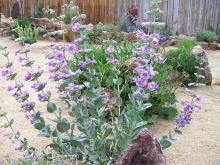
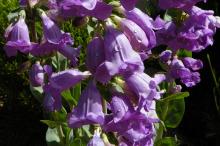
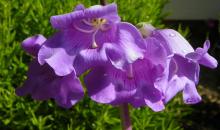
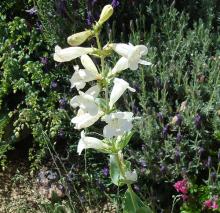
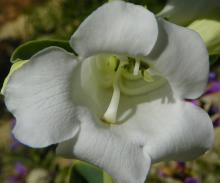
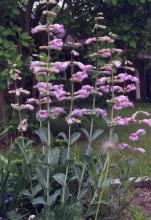
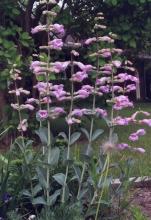
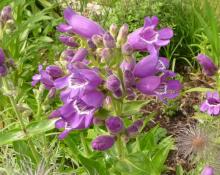
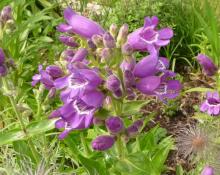
Gorgeous. This species barely enters Colorado near the Kansas border. I find it monocarpic or nearly so in the front yard (with zero irrigation), but longer lived elsewhere in the garden.
'April Snow' (I think that's the right name; the white one) practically stops traffic. Well, they all do, if people drive slowly.
Bob